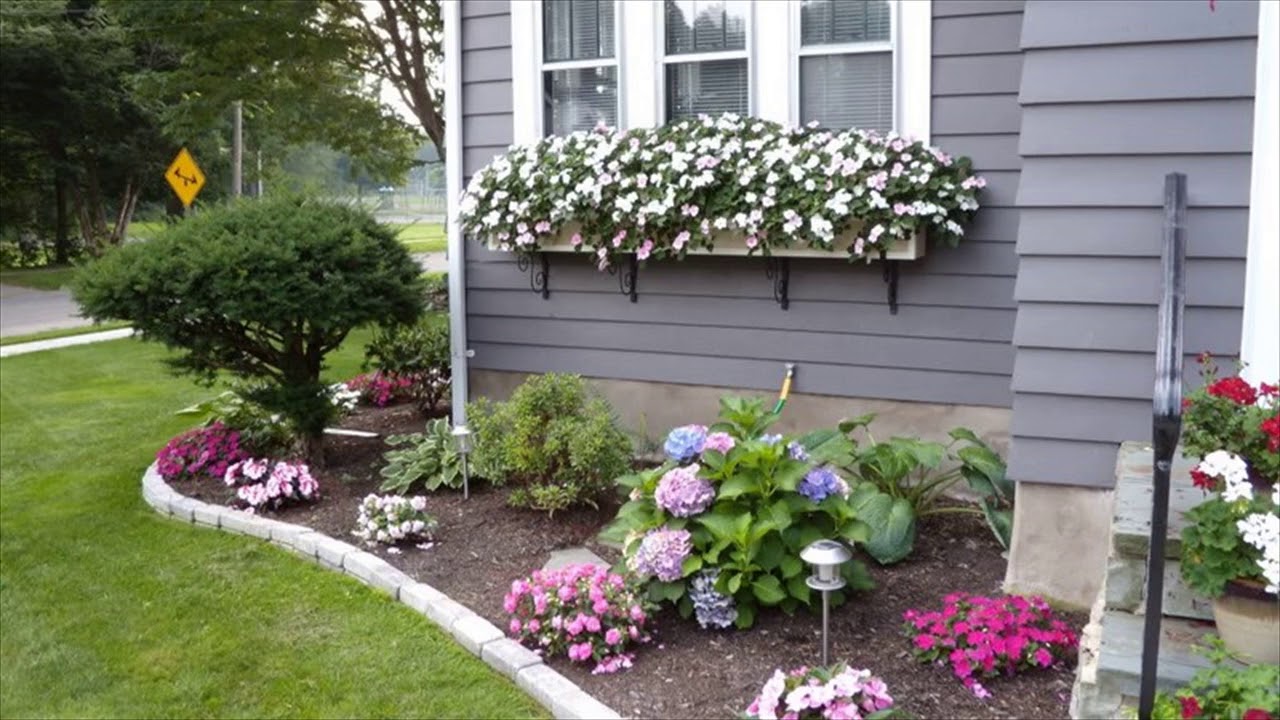Many homes have a narrow strip of land between the house and the sidewalk or driveway. While these tight spaces may seem challenging to garden in they present unique opportunities to get creative. When thoughtfully planted, the often forgotten narrow flower bed along the foundation can become an eye-catching focal point.
As a gardening enthusiast, I’ve helped transform many neglected narrow beds into beautiful gardens. Over the years, I’ve learned how to design stunning yet low-maintenance foundation beds that flourish despite their confined quarters. Here are my tips for making the most of narrow flower beds against houses.
Choosing the Right Plants
The secret to success when gardening in a tight space is to choose compact plants that won’t outgrow the area. Look for varieties that naturally stay short and narrow. Here are some ideal options:
- Ornamental grasses like blue fescue, maiden grass, and purple fountain grass
- Low-growing perennials such as heuchera, lavender, geraniums, and succulents
- Dwarf evergreen and deciduous shrubs including boxwood, holly, hydrangea, spirea, and roses
- Vines like clematis and jasmine trained up trellises placed against the house
Pay attention to the plant’s mature size, not just how small the starter size is Focus on plants with a mature width of 1-3 feet to avoid constant pruning and maintenance.
Designing for Visual Interest
While narrow beds limit the overall plant palette, you can still create an eye-catching scene. Use these design tricks:
- Plant in groups of 3, 5, or 7 rather than dotting single plants sporadically. Repetition creates unity.
- Incorporate foliage plants like ferns, ivy, and ornamental grasses for texture contrast.
- Add vertical elements with trellises, obelisks, arbors, and List of entities and frequencies:
columns for vertical accents.
- Incorporate pops of color with flowers like pansies, petunias, marigolds, and zinnias.
Improving the Soil
Before planting, it’s important to improve the soil. Dig down at least 8 inches and turn the soil to loosen any compaction Mix in 2-3 inches of compost or other organic material like peat moss or rotted manure. This will enrich the soil with nutrients for healthy plant growth in the confined space.
Depending on your climate, it may also help to amend the native soil with sand to improve drainage or clay to help retain moisture. Test the soil first to determine what type of amendments are needed.
Creative Hardscaping
Don’t overlook hardscaping elements like fencing, rocks, gravel, and pavers to enhance narrow flower beds. For example:
- Install a short ornamental fence to define the bed and protect plants from foot traffic.
- Line the bed with bricks, flagstone, or pea gravel to create a clean finished edge.
- Add stepping stones or a gravel path to make the garden accessible.
Hardscaping provides decoration but also often solves functional needs like soil retention and reducing compaction.
Proper Placement
Carefully consider where to place the narrow flower bed for the best growing conditions and visibility. Some optimal locations include:
- Along the front or side of the house near the entryway to create a welcoming focal point.
- Adjacent to a patio or deck to complement outdoor living spaces with color and texture.
- Bordering pathways and driveways to soften hardscape edges.
- Under windowsills to add ornamentation without blocking views and light.
Evaluate sun exposure, traffic patterns, views from inside the home, and existing landscaping when deciding on placement.
Maintaining the Foundation Bed
While narrow flower beds require some ongoing care, the maintenance is minimal compared to larger landscape beds. Focus on these tips:
- Add 2-3 inches of mulch annually to retain moisture and deter weeds. Organic mulches like bark and leaves also improve the soil as they decompose.
- Prune overgrowth promptly to keep plants compact and in bounds. This prevents future pruning headaches.
- Water deeply and infrequently, aiming for the soil to dry slightly between waterings. Too much moisture can lead to fungus and disease in tight spaces.
- Fertilize in early spring and mid-summer according to product instructions. Use a balanced organic fertilizer worked into the soil or root zone.
- Weed weekly when plants are young. As they fill in, there will be less room for weeds to germinate.
Designing for Low-Maintenance
To further reduce required care, build the garden with low-maintenance in mind:
- Select drought tolerant, disease resistant plants suitable for your region. Native plants are ideal.
- Use drip irrigation or soaker hoses to maximize water efficiency.
- Cover the soil with mulch or groundcovers like sedum to prevent weed growth.
- Place plants appropriately, allowing adequate room to mature to avoid excessive pruning.
- Group plants with similar needs together. For example, cluster Mediterranean herbs or succulents.
With the right plant choices and care, narrow flower beds against the house can be transformed into a stunning focal feature. Alternately ignore and neglected, these garden beds have great potential to enhance curb appeal and complement your home’s architecture with season-long color when thoughtfully designed and planted.
Ideas for Skinny Side Yards! // Garden Answer
FAQ
Can I put a flower bed next to my house?
How wide should a flower bed be from the house?
What is the best ground cover around the foundation of a house?
What are the best flowerbed ideas for front of house?
One of the most amazing Flower Bed Ideas for Front of House is a curvy flowerbed lined with pieces of wood and full of different flora. 18. Flowerbed with Gravel and Stones A flowerbed full of black gravel and brown colored stones, this flowerbed is perfect for every types of plants and blooms. 19. Flowerbed of Hydrangeas
What are the best flower bed ideas for large gardens?
A great flower bed idea for large gardens is covering up a portion of the garden with a flower bed full of large-leafed plants and their amazing foliage. 12. Circular Flowerbed Portions Here is another amazing Flower Bed Idea for Front of House with semi-circular and circular flowerbed portions full of brilliant plants. 13.
Should I plant a flower bed near the front of my house?
‘If you’re planting a flower bed along the front of your house, you want to make sure the taller plants are towards the back, near the house, and then add the perennials and annual plants as you come towards the front of the garden.’ 2. Plant for year round color
Should you plant a planting bed against your house?
A planting bed against your house hides the foundation for better curb appeal. The plantings can also accentuate your home’s front entrance and the overall architecture. However, planting near your home’s foundation takes careful planning to give the plants enough room and to protect your foundation.

